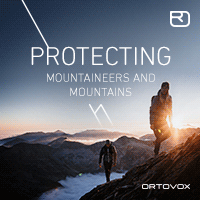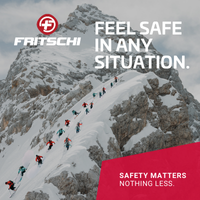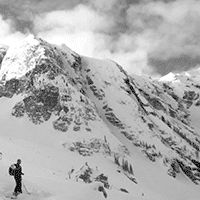Polar bears and faceshots in Spitsbergen
My heart's pounding and suddenly I'm wide-awake. Terrified and freezing cold, I sit up straight in my thick down sleeping bag. I know the sound that woke me: it was definitely a growl! Before this expedition it was the skiing that captured my imagination, but now it's the polar bear stories that keep me wide awake at night. Polar bears form a real danger on the island of Spitsbergen. In fact there are more polar bears (around 3,000) than human inhabitants, and rifles are compulsory if you leave town. I prick up my ears, but all is quiet in the tent and my companions seem to be fast asleep. My heartbeat slows. The infra-red alarm, also known as our 'polar bear alarm', didn't go off and Jarle the husky, who's guarding us outside, hasn't stirred. Phew, false polar bear alarm!

(click the images for a larger view)
Spitsbergen
Caroline and I, two Dutch ski journalists without any winter camping experience whatsoever, have joined a group of international adventurers on a ski expedition in Spitsbergen. We're in the safe hands of our experienced guide, Tobias Luthe. Like us, he combines his passion with his work; as well as being a ski guide, he is a Sustainability Science professor at the University of Chur, Switzerland and he organized this Science Wilderness Experience.
We set off on a tiny zodiac boat. Perched just above the freezing water, we fly across the icy fjord. We are dropped off, 40 kilometers northeast of the capital, Longyearbyen, with just a couple of sledges ('pulkas') with all our gear: two tents, food, three rifles and very little extra clothing. Less is more, as we will be pulling the pulkas ourselves and we’ll be finding our own way back to Longyearbyen in five days’ time.

Midnight snack
Rifle firmly strapped to my backpack, we head out into the glorious sunshine. Although it's almost 9:30 PM, time has little relevance in this beautiful setting. So far north, at 78 degrees north latitude and just 1,338 kilometers from the North Pole, in early May daylight lasts for 24 hours and so there's no pressure to be back in camp before dark! We admire the boundless, treeless landscape, dominated by dozens of sharp peaks rising from the surrounding fjords like triangular pyramids, in stark contrast with the clear blue sky. Step by step, we work our way up in complete silence. In this vast landscape, we feel so deeply connected to Mother Nature that we can’t help but immediately relax. It’s close to midnight by the time we reach the summit at 935 meters. Tobias puts away his skins and says with a big smile: “You don’t need to be afraid that your line will be tracked. The only track you’ll see will be that of a polar bear.”

Science Experience Wilderness
Tobias turns out to be a jack-of-all-trades. Not only is he our ski guide as well as a professor, he also has his own eco ski brand called “Grown” and organizes these Science Experience Wilderness trips to several locations. Although this week's trip is mostly about skiing, Tobias sometimes invites us to share ideas about the development of this extremely remote area. He’s quite the local expert as he leads a scientific research on the interaction between nature (ecosystems) and people (social economic systems). During a delicious and well-earned dinner of salmon and mashed potatoes he shares the changes he has witnessed in Spitsbergen over the last few years. Mining used to be the main industry until tourism took off: nowadays, more than 40,000 cruise passengers visit Spitsbergen every year. Due to the extreme Arctic climate most inhabitants leave after a few years. As a consequence there are hardly any locals and the lack of a close community makes it difficult to make any structural plans for the long-term protection of this wild place. We, for example, choose not to use the oh-so-popular snowmobile during our trip in order to minimize our footprint.

Details:
About us:
If you want to find out more about Spitsbergen or our other travel adventures, please follow us on Facebook and Instagram!









